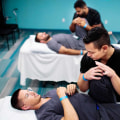Physical therapy is a cornerstone of rehabilitation for individuals recovering from injury, surgery, or managing chronic pain. One of the most effective tools physical therapists use is therapeutic exercise. These exercises are tailored to each patient’s condition, goals, and limitations, and they focus on improving strength, flexibility, balance, coordination, and endurance. The types of exercises prescribed can vary widely depending on the diagnosis, but they all share a common goal: restoring function and enhancing quality of life.
Range of Motion and Flexibility Exercises
When joints become stiff or muscles tighten due to injury or inactivity, range of motion and flexibility exercises are used to restore movement. These may include passive exercises, where a therapist moves the limb for the patient, or active-assisted and active stretches that patients perform themselves. These movements help lubricate the joints, reduce stiffness, and increase flexibility. They are often the first step in a rehabilitation program, especially after surgery or long periods of immobility, and they pave the way for more advanced exercises as the patient improves.
Strengthening Exercises
Strengthening exercises are crucial for rebuilding muscle and supporting injured or weak areas of the body. These may involve the use of resistance bands, light weights, or body weight. Therapists typically begin with isometric exercises, which involve muscle contractions without movement, and gradually progress to isotonic and functional strength exercises. The goal is not only to rebuild strength but also to prevent future injuries by stabilizing joints and improving muscular balance. Strength training in physical therapy is carefully monitored to avoid strain and promote proper technique.
Balance and Proprioception Training
Balance and proprioception exercises are particularly important for individuals recovering from lower limb injuries, neurological conditions, or those at risk of falls. These exercises train the body to maintain stability and improve awareness of body position. Simple activities like standing on one foot, walking heel to toe, or using balance boards challenge the body’s equilibrium and improve confidence in movement. Over time, these exercises help patients regain a sense of control and prevent accidents that can lead to re-injury.
Aerobic Conditioning and Endurance Building
For patients managing cardiovascular issues, recovering from major surgery, or dealing with conditions like fibromyalgia or chronic fatigue, low-impact aerobic exercises are a vital component of physical therapy. Activities like walking on a treadmill, cycling on a stationary bike, or swimming help improve cardiovascular health, boost energy levels, and promote overall wellness. These exercises are introduced gradually to match the patient’s tolerance and are often combined with strength and flexibility routines for a well-rounded program.
Neuromuscular Re-education and Functional Training
Neuromuscular re-education focuses on retraining the body’s movement patterns after a neurological event like a stroke or traumatic brain injury. These exercises help rebuild coordination and improve motor control. Functional training, meanwhile, targets specific tasks like lifting, sitting, or climbing stairs—everyday activities that many take for granted until mobility is lost. These practical exercises help patients transition from the clinic to independent living with confidence.
Holistic Approaches and Complementary Therapies
Many physical therapy programs today incorporate holistic and complementary approaches to enhance results. Techniques like dry needling, manual therapy, and even acupuncture in Durham are often used to reduce pain and promote healing. These additions can make a significant difference, especially for patients dealing with chronic conditions or seeking a more natural path to recovery.
Empowering Recovery Through Movement
Ultimately, the power of physical therapy lies in its ability to empower patients through movement. The exercises used are more than just routines—they are carefully chosen tools that restore independence, relieve pain, and rebuild lives. Whether recovering from a sprain or managing a lifelong condition, physical therapy offers a path forward—one movement at a time.






